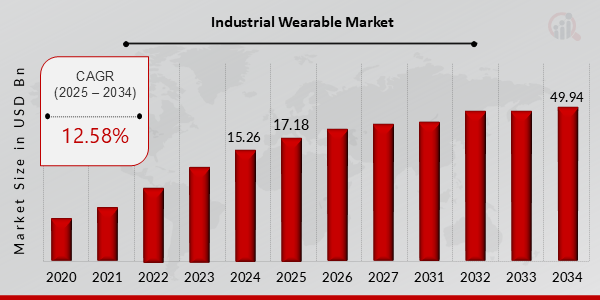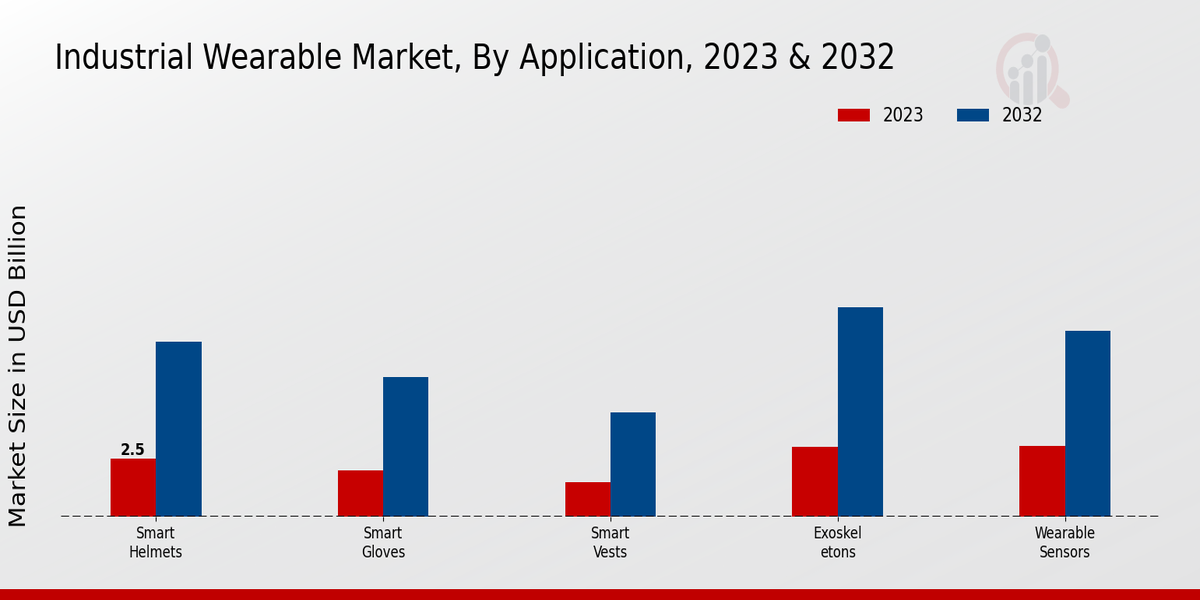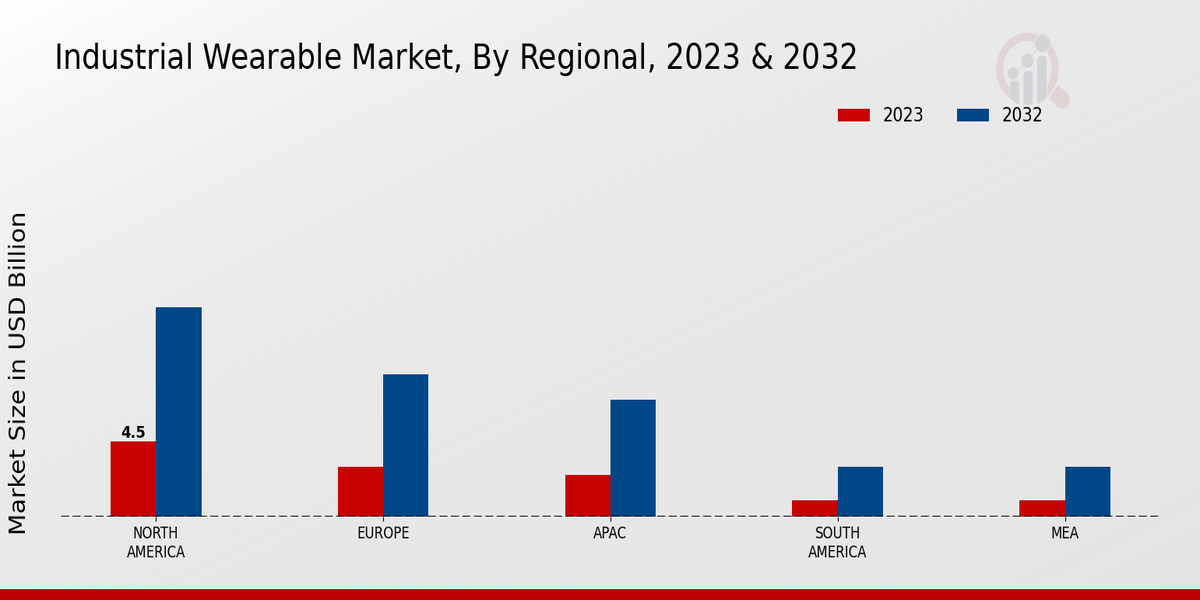Global Industrial Wearable Market Overview
Industrial Wearable Market Size was estimated at 15.26 (USD Billion) in 2024. The Industrial Wearable Market Industry is expected to grow from 17.18 (USD Billion) in 2025 to 49.94 (USD Billion) till 2034, exhibiting a compound annual growth rate (CAGR) of 12.58% during the forecast period (2025 - 2034)
Key Industrial Wearable Market Trends Highlighted
The Global Industrial Wearable Market is being driven by several key factors. The increasing need for worker safety and efficiency in industries is propelling the adoption of wearables that monitor health and safety conditions in real time. Businesses are also recognizing the potential of these devices to enhance productivity by providing valuable data analytics about worker performance and environmental conditions.
Moreover, advancements in technology, including the Internet of Things (IoT) and artificial intelligence, are facilitating the integration of wearables into everyday industrial practices, making them more appealing for manufacturers looking to streamline operations.There are numerous opportunities to be explored in this market.
Companies can tap into the rising demand for customized wearable solutions tailored to specific industry needs, such as construction, manufacturing, and logistics. The integration of wearables with augmented reality (AR) offers businesses a chance to improve training processes and on-site support. Additionally, there's potential for expanding into developing regions where safety regulations are becoming stricter, prompting the need for such technologies.
Partnerships and collaborations with tech firms can also help drive innovation and create product offerings that meet evolving industry challenges.Recent trends show a growing preference for hands-free devices, enabling workers to perform tasks without distraction while still accessing vital information.
This shift towards mobility is complemented by the incorporation of data analytics to provide actionable insights into workplace conditions. Furthermore, increasing investments in workplace safety technologies indicate a robust trajectory for the sector. As companies increasingly prioritize employee well-being and operational efficiency, the industrial wearable market is likely to evolve, driven by continuous technological upgrades and a deeper understanding of worker needs. The focus on intuitive and user-friendly designs also highlights a commitment to enhancing the overall user experience, making wearables more accessible and effective.

Source: Primary Research, Secondary Research, MRFR Database and Analyst Review
Industrial Wearable Market Drivers
Advancements in Technology and Connectivity
The rapid advancement of technology and connectivity is a significant driver for the Global Industrial Wearable Market Industry. Wearable technology has evolved dramatically over recent years, leading to the development of devices that are more sophisticated, lightweight, and user-friendly. The integration of advanced sensors, artificial intelligence, and the Internet of Things (IoT) has enabled the creation of wearables that can capture and analyze data in real time.This data can provide critical insights into worker performance, health conditions, and safety protocols, ultimately enhancing productivity and reducing workplace accidents.
In addition, enhanced connectivity features, such as 5G, enable instant data transmission, further improving the functionality of these devices. More industries are recognizing the potential of wearables in streamlining operations and enhancing safety measures. As organizations continue to invest in new technologies, the adoption of industrial wearables is expected to accelerate, driving significant growth in the Global Industrial Wearable Market Industry.
Increasing Focus on Worker Safety and Health
The growing emphasis on workforce safety and health is a primary driver behind the Global Industrial Wearable Market Industry. Industries are becoming increasingly aware of the need to protect their employees and improve overall working conditions. Wearable technology plays a crucial role in achieving these goals, as these devices can monitor health indicators, alert workers of potential hazards, and provide real-time safety feedback. Companies are focusing on minimizing workplace accidents and ensuring compliance with safety regulations, which is significantly pushing for the adoption of industrial wearables.
Rising Demand for Operational Efficiency
The increased demand for operational efficiency among organizations is fueling the growth of the Global Industrial Wearable Market Industry. Companies are constantly seeking innovative solutions to optimize their processes, reduce costs, and improve productivity. Industrial wearables can facilitate better communication, streamline operations, and enhance decision-making on the shop floor. This demand for efficiency is driving companies to invest in these wearable technologies, transforming traditional work environments into more efficient and effective operations.
Industrial Wearable Market Segment Insights:
Industrial Wearable Market Application Insights
The Global Industrial Wearable Market, which encompasses various applications, is projected to demonstrate significant growth, attributed to increasing demands for improved safety, efficiency, and productivity in industrial settings. In 2023, the Smart Helmets segment holds a substantial market value of 2.5 USD Billion and is expected to reach 7.5 USD Billion by 2032, showcasing its crucial role in enhancing worker safety through augmented reality and real-time data visualization capabilities.
Smart Gloves, valued at 2.0 USD Billion in 2023, are anticipated to grow to 6.0 USD Billion by 2032, providing tactile feedback and enabling skilled manipulation in environments where precision is essential.The Smart Vests segment, starting at 1.5 USD Billion in 2023 and projected to rise to 4.5 USD Billion by 2032, is significant for its ability to monitor vital signs and provide actionable data for health management and safety compliance.
Exoskeletons, leading with an initial valuation of 3.0 USD Billion in 2023 and expected to reach 9.0 USD Billion by 2032, dominate the market due to their transformative potential in reducing fatigue and preventing injuries in physically demanding jobs.
Additionally, Wearable Sensors, valued at 3.05 USD Billion in 2023 and forecasted to climb to 8.0 USD Billion by 2032, play a vital role in data collection and environmental monitoring, further enhancing safety protocols and operational efficiency.Overall, the Global Industrial Wearable Market segmentation reveals a diverse landscape wherein each application contributes uniquely to advancing workplace safety and productivity, evidenced by their respective market valuations and projected growth trajectories. The growing integration of technology in these wearables drives the market forward, providing opportunities for innovation and development within the industry, aligning with current trends toward smart and connected industrial solutions.

Source: Primary Research, Secondary Research, MRFR Database and Analyst Review
Industrial Wearable Market End Use Insights
The Global Industrial Wearable Market revenue is on track for significant growth, expected to be valued at 12.05 USD Billion in 2023. This market comprises several key areas of application, highlighting the versatility and importance of wearable technology in industrial settings. The Manufacturing sector is notable for driving demand due to the increasing adoption of smart glasses and other wearable devices that enhance productivity and safety compliance. Construction is another critical area where technology has become essential, as wearables help monitor worker safety and optimize project workflows.
Logistics also plays a vital role, with wearables such as scanners and GPS devices significantly improving tracking and inventory management. The Healthcare industry utilizes wearables for remote patient monitoring and to enhance worker safety in medical environments. Mining, known for its hazardous conditions, benefits greatly from wearables that monitor environmental conditions and worker health.
As these sectors continue to expand, there is an evident push toward technological advancements, underlining the importance of the Global Industrial Wearable Market segmentation in addressing industry-specific challenges and enhancing operational efficiencies.The expected CAGR of 12.58 from 2024 to 2032 reflects ongoing innovations and growing acceptance of industrial wearables across these sectors.
Industrial Wearable Market Product Type Insights
The Global Industrial Wearable Market is experiencing considerable growth, with a market valuation of 12.05 USD billion on track to reach 35.0 USD billion by 2032. This expansion is driven by a robust expected CAGR of 12.58 from 2024 to 2032, highlighting the increasing adoption of wearable technologies across sectors. Within the Product Type segment, Head-Mounted Displays are gaining traction due to their capacity to provide immersive training and real-time information, thus enhancing productivity in industrial settings.
Body-Worn Devices also play a crucial role, as they allow for continuous monitoring of workers' health and safety, thus contributing to overall operational efficiency.
Sensing Devices are gaining importance as they support data collection for analytics and decision-making. Overall, the segmentation in the Global Industrial Wearable Market illustrates a diverse ecosystem that caters to various industrial needs, with each type significantly impacting market growth and efficiency. The trends within this market reflect an increasing reliance on smart technology to improve workplace safety and efficiency.
Industrial Wearable Market Connectivity Insights
The Connectivity segment of the Global Industrial Wearable Market plays a pivotal role in enhancing operational efficiency across industries. In 2023, the overall market was valued at 12.05 billion USD, reflecting a strong inclination towards wearable technologies that facilitate seamless communication and data exchange. Technologies such as Bluetooth, Wi-Fi, and Zigbee have emerged as critical components, allowing devices to remain interconnected in real time.
Bluetooth is particularly significant due to its low energy consumption and wide compatibility with various devices, making it ideal for numerous applications in industrial settings.Wi-Fi provides robust data throughput and extended range, catering to industries that require high-bandwidth applications, while Zigbee offers low-power communication suitable for monitoring systems.
As industries increasingly adopt these technologies for efficiency and productivity, the momentum of the Global Industrial Wearable Market is expected to increase, driven by rising demand for innovative wearable solutions that enhance connectivity and real-time data accessibility. With the growing trend towards Industry 4.0 and automation, the development and implementation of these connectivity solutions present substantial opportunities in the Global Industrial Wearable Market's evolution.
Industrial Wearable Market Regional Insights
The Global Industrial Wearable Market is set to experience robust growth, with North America leading the regional segmentation, valued at 4.5 USD Billion in 2023, and expected to rise to 12.5 USD Billion by 2032, showcasing its dominance. Europe follows with a valuation of 3.0 USD Billion in 2023, projected to grow to 8.5 USD Billion, driven by advancements in technology and increased adoption of wearables in various industries.
Meanwhile, the APAC region, valued at 2.5 USD Billion in 2023 and expected to reach 7.0 USD Billion, demonstrates significant potential due to its expanding manufacturing sector and rising demand for operational efficiency.
South America and MEA each hold a smaller portion of the market, valued at 1.0 USD Billion in 2023, with both anticipated to grow to 3.0 USD Billion. The relatively lower market values in these regions highlight opportunities for growth as industrial sectors evolve and embrace wearable technologies. Overall, the Global Industrial Wearable Market represents a dynamic landscape driven by technological innovations, with North America maintaining a majority holding in market revenue and Europe and APAC emerging as key players.

Source: Primary Research, Secondary Research, MRFR Database and Analyst Review
Industrial Wearable Market Key Players and Competitive Insights:
The Global Industrial Wearable Market is rapidly evolving, characterized by significant technological advancements that are reshaping the landscape of industrial operations. This market encompasses a wide range of wearable devices designed to enhance employee safety, improve operational efficiency, and optimize workflow in various sectors, including manufacturing, logistics, and healthcare. Strong competition among key players is driving innovation and fostering the development of more sophisticated, user-friendly wearables that are increasingly integrated with the Internet of Things (IoT), artificial intelligence, and data analytics.
As organizations recognize the benefits of implementing wearables for real-time monitoring and data collection, the market is expected to witness substantial growth, leading to a dynamic competitive environment with ongoing product launches and strategic partnerships as companies vie for market share.Daqri stands out in the Global Industrial Wearable Market due to its innovative approach to augmented reality. The company has developed advanced wearable solutions that enhance the capabilities of field workers by providing them with real-time data and visualizations directly within their line of sight.
By leveraging augmented reality technology, Daqri's products facilitate intuitive hands-free operations, allowing users to access critical information without diverting their attention from their tasks. The strength of Daqri lies in its focus on enhancing workplace safety and productivity, enabling organizations to minimize errors and optimize task performance.
The seamless integration of wearable devices into existing enterprise workflows enhances overall operational efficiency, reinforcing Daqri's competitive position in a rapidly growing market.Zebra Technologies is another prominent player in the Global Industrial Wearable Market, known for its robust suite of solutions designed to streamline operations across various industries. The company offers a range of wearable devices, including smart glasses and wrist-mounted computers, which empower workers with immediate access to essential data and communications. Zebra's strength lies in its extensive industry experience and commitment to innovation, which translates into highly reliable products that can withstand the demands of challenging environments.
The user-friendly interface of Zebra’s wearables, combined with their ability to integrate seamlessly with inventory management systems and analytics platforms, provides customers with valuable insights into their operations. This capability helps businesses enhance efficiency and improve decision-making processes, positioning Zebra Technologies as a significant competitor in the industrial wearable space.
Key Companies in the Industrial Wearable Market Include:
Industrial Wearable Market Industry Developments
The Global Industrial Wearable Market is witnessing notable advancements, with companies such as Daqri, Zebra Technologies, RealWear, Honeywell, and Microsoft at the forefront of innovation. Recent developments include improvements in augmented reality (AR) solutions and smart glasses designed to enhance productivity and safety in industrial environments. Zebra Technologies recently expanded its product line to include wearable devices integrated with advanced analytics, catering specifically to warehouse and logistics sectors. In a significant shift, Apple has been enhancing its smartwatch functionalities for industrial applications, focusing on health monitoring and predictive maintenance.
Companies like Emerson and GE Digital are pushing for IoT integrations with wearable technology, offering real-time data analytics for operational efficiency. In terms of market dynamics, there has been a notable growth in the valuation of firms engaged in developing wearable technology, significantly impacting the market landscape. Reports indicate that consolidation activities may be on the horizon, with potential collaborations or acquisitions involving major players like Siemens, PTC, and Vuzix, aimed at leveraging combined technological strengths to capture a larger market share.
The strategic movements underscore the growing recognition of wearables in increasing operational efficiency and safety standards across various industries.
Industrial Wearable Market Segmentation Insights
-
Industrial Wearable Market Application Outlook
-
Industrial Wearable Market End Use Outlook
-
Industrial Wearable Market Product Type Outlook
-
Industrial Wearable Market Connectivity Outlook
-
Industrial Wearable Market Regional Outlook
|
Report Attribute/Metric
|
Details
|
|
Market Size 2024
|
USD 15.26 Billion
|
|
Market Size 2025
|
USD 17.18 Billion
|
|
Market Size 2034
|
USD 49.94 Billion
|
|
Compound Annual Growth Rate (CAGR)
|
12.58% (2025-2034)
|
|
Base Year
|
2024
|
|
Market Forecast Period
|
2025-2034
|
|
Historical Data
|
2020-2023
|
| Market Forecast Units |
USD Billion |
| Key Companies Profiled |
Daqri, Zebra Technologies, RealWear, Honeywell, Microsoft, Apple, Emerson, GE Digital, PTC, Vuzix, Xenosys, Siemens, Nintendo, Google, Lenovo |
| Segments Covered |
Application, End Use, Product Type, Connectivity, Regional |
| Key Market Opportunities |
Increased demand for safety solutions, Growth in IoT integration, Rise in remote monitoring needs, Enhanced workforce productivity requirements, Expansion in wearable technology adoption |
| Key Market Dynamics |
Technological advancements, Workforce safety enhancement, Operational efficiency improvement, Increased demand for data analytics, Rise in remote collaboration tools |
| Countries Covered |
North America, Europe, APAC, South America, MEA |
Frequently Asked Questions (FAQ):
The Global Industrial Wearable Market is expected to be valued at 49.94 USD Billion in 2034.
The expected CAGR of the Global Industrial Wearable Market from 2025 to 2034 is 12.58%.
North America is projected to have the largest market share, valued at 12.5 USD Billion in 2032.
Smart Gloves are expected to reach a market size of 6.0 USD Billion in 2032.
Major players in the market include Daqri, Zebra Technologies, RealWear, Honeywell, and Microsoft.
Smart Helmets are valued at 2.5 USD Billion in the year 2023.
The Exoskeleton market is expected to grow to 9.0 USD Billion by 2032.
Wearable Sensors is valued at 3.05 USD Billion in the year 2023.
Smart Helmets are projected to experience significant growth, expected to reach 7.5 USD Billion in 2032.
South America is expected to reach a market value of 3.0 USD Billion in 2032.

















